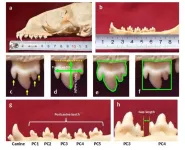(Press-News.org) Embargoed until 08:00 AM GMT / 04:00 AM ET Friday 22 March 2024
Bees need food up to a month earlier than provided by recommended pollinator plants
Plant species which are recommended as ‘pollinator friendly’ in Europe begin flowering up to a month too late for bees, resulting in low colony survival and low production of queens.
This is the first time that research has quantified the decline in colony survival and queen production due to a shortage of early season food.
Enhancing existing hedgerows with early blooming species has the potential to increase the probability that a bee colony survives from 35% to 100%.
New research from the Universities of Oxford and Exeter has revealed that plant species recommended as ‘pollinator friendly’* in Europe begin flowering up to a month too late in the spring to effectively contribute to bee conservation. This ‘hungry gap’ results in low colony survival and low production of queens for the following year. The results showed that pollen and nectar availability during the early colony founding stage is a critical, and previously under-appreciated, factor in bee colony success.** The study has been published in the journal Insect Conservation and Diversity.
Senior author Dr Tonya Lander (Department of Biology, University of Oxford) said: “The results give us a simple and practical recommendation to help bees: to enhance hedgerows with early blooming species, especially ground ivy, red dead-nettle, maple, cherry, hawthorn, and willow, which improved colony success rate from 35% to 100%. This approach focuses on existing hedgerows in agricultural land and doesn’t reduce farm cropping area, so can appeal to land managers whilst also providing important conservation outcomes for pollinators.”
The study looked at two example European species: the buff-tailed bumblebee (Bombus terrestrisi) and the common carder bee (B. pascuorum). These were assessed using the BEE-STEWARD model, which integrates data and runs simulations to predict how changes in different factors may impact bee populations over time. The researchers explored when during the year bumblebee food (pollen and nectar) demand is highest, how colony survival is impacted by periods of food scarcity, how food requirements relate to seasonal changes in colony composition (numbers of adults, eggs, larvae, and pupae), and how availability of early spring-blooming plants affects colony survival and queen production.
The results showed that bumblebee food demand is highest March to June, and lack of food during this critical period has catastrophic consequences for colony survival and queen production, increasing the risk of local population extinction. March and April are particularly critical months, where a two-week gap in forage availability can result in a 50-87% drop in the production of daughter queens.
Dr Matthias Becher (University of Exeter and Rifcon) said: “We were surprised to find that the colony’s demand for nectar and pollen is driven mainly by the number of larvae rather than the number of adult workers. This explains the particularly high colony demand in March and April, before the adult workers are usually seen foraging outside the colony. The larvae need pollen for growth, and most of the energy from nectar is used for thermal regulation of the brood.”
Despite years of pollinator planting and conservation initiatives, pollinators are still in decline around the world. Very early spring flowers are likely to increase bee colony survival and queen production, contributing towards halting and reversing this decline.
*Plant species recommended for pollinators are those given by the United Kingdom Countryside Stewardship Program and Local Nature Recovery scheme (DEFRA), the United States Department of Agriculture Pollinator Habitat Initiative (USDA CP-42), and the European Union Pollinators Initiative.
** ‘Bee colony success’ is defined as the bee colony surviving until the end of the season and producing new queens for the following season.
Notes to editors
Interviews with the authors are available on request:
Matthias A. Becher: matthias.becher@rifcon.de / +49 (0) 6201 84528 00
Tonya Lander: tonya.lander@biology.ox.ac.uk
The paper ‘Resource gaps pose the greatest threat for bumblebees during the colony establishment phase’ will be published in the journal Insect Conservation and Diversity. It will be available online when the embargo lifts at
DOI: https://doi.org/10.1111/icad.12736
URL: https://resjournals.onlinelibrary.wiley.com/doi/full/10.1111/icad.12736
To view a copy of the manuscript before this under embargo, contact Dr Tonya Lander: tonya.lander@biology.ox.ac.uk
About the University of Oxford
Oxford University has been placed number 1 in the Times Higher Education World University Rankings for the eighth year running, and number 3 in the QS World Rankings 2024. At the heart of this success are the twin-pillars of our ground-breaking research and innovation and our distinctive educational offer.
Oxford is world-famous for research and teaching excellence and home to some of the most talented people from across the globe. Our work helps the lives of millions, solving real-world problems through a huge network of partnerships and collaborations. The breadth and interdisciplinary nature of our research alongside our personalised approach to teaching sparks imaginative and inventive insights and solutions.
Through its research commercialisation arm, Oxford University Innovation, Oxford is the highest university patent filer in the UK and is ranked first in the UK for university spinouts, having created more than 300 new companies since 1988. Over a third of these companies have been created in the past five years. The university is a catalyst for prosperity in Oxfordshire and the United Kingdom, contributing £15.7 billion to the UK economy in 2018/19, and supports more than 28,000 full time jobs.
The Department of Biology is a University of Oxford department within the Maths, Physical, and Life Sciences Division. It utilises academic strength in a broad range of bioscience disciplines to tackle global challenges such as food security, biodiversity loss, climate change and global pandemics. It also helps to train and equip the biologists of the future through holistic undergraduate and graduate courses. For more information visit www.biology.ox.ac.uk.
END
Bees need food up to a month earlier than provided by recommended pollinator plants
2024-03-22
ELSE PRESS RELEASES FROM THIS DATE:
Discovery of a hidden quantum critical point in two-dimensional superconductors
2024-03-22
Weak fluctuations in superconductivity1, a precursor phenomenon to superconductivity, have been successfully detected by a research group of Tokyo Institute of Technology (Tokyo Tech). This breakthrough was achieved by measuring the thermoelectric effect2 in superconductors over a wide range of magnetic fields and over a wide range of temperatures from much higher than the superconducting transition temperature to very low temperatures near absolute zero. This revealed the full picture of fluctuations in superconductivity ...
Multi-cusped postcanine teeth are associated with zooplankton feeding in phocid seals.
2024-03-22
The morphology of an animal's teeth often reflects its diet. A well-known example of a mammal that feeds in the water is the crabeater seal (Lobodon carcinophaga), which consumes large amounts of zooplankton. Crabeater seals have complex, jagged teeth, which are believed to function as a sieve to retain krill in their mouths and filter it from seawater. Furthermore, recent studies have shown that the Baikal seal (Pusa sibirica) also preys on large quantities of zooplankton and possesses distinctive jagged teeth. Thus, while behavioral observations and tooth morphology studies suggest a ...
Outcomes after stem cell transplant in elderly patients with acute myeloid leukemia have improved since 2000
2024-03-22
Bottom Line: Among patients over 65 who received an allogeneic hematopoietic stem cell transplant (allo-HCT) for the treatment of acute myeloid leukemia (AML) between 2000 and 2021, leukemia-free and overall survival improved significantly over time.
Journal in Which the Study was Published: Clinical Cancer Research, a journal of the American Association for Cancer Research (AACR)
Author: Ali Bazarbachi, MD, PhD, senior author of the study and a professor at the American University of Beirut in Lebanon
Background: AML ...
Longer genes are linked to aging
2024-03-22
· Long genes have more potential sites for DNA damage
· Genes involved in brain loss during aging and linked to Alzheimer’s are very long
· New view of biological aging differs from previous beliefs
CHICAGO --- What causes our body to age? Four complementary studies, including one from Northwestern Medicine, have come to the same conclusion: long genes.
In a new paper, the scientists write about their findings and how they advance existing knowledge about aging.
“Long genes ...
Revolutionizing hydrogen production: Economical and efficient solutions unveiled
2024-03-22
Water eletrolysis process is a system that produces hydrogen by electrolyzing water. It is an eco-friendly technology that can produce hydrogen fuel, a future energy source, without emitting environmental pollutants, but its limitations have been pointed out as low hydrogen production efficiency and high production costs. Recently, a team of researchers from Pohang University of Science and Technology (POSTECH) published research that solved both problems at once, attracting attention.
A collaborative research team comprising Professor Jong Kyu Kim, Jaerim Kim, a Ph. D. candidate, Professor ...
James Webb Space Telescope captures the end of planet formation
2024-03-22
Scientists believe that planetary systems like our solar system contain more rocky objects than gas-rich ones. Around our sun, these include the inner planets – Mercury, Venus, Earth and Mars – the asteroid belt and the Kuiper belt objects such as Pluto.
Jupiter, Saturn, Uranus and Neptune, on the other hand, contain mostly gas. But scientists also have known for a long time that planet-forming disks start out with 100 times more mass in gas than solids, which leads to a pressing question: When ...
If faces look like demons, you could have this extraordinary condition
2024-03-22
Imagine if every time you saw a face, it appeared distorted. Well, for those who have a very rare condition known as prosopometamorphopsia (PMO), which causes facial features to appear distorted, that is reality.
As the Dartmouth-based website about prosopometamorphopsia explains, "'Prosopo' comes from the Greek word for face 'prosopon' while 'metamorphopsia' refers to perceptual distortions.''' Specific symptoms vary from case to case and can affect the shape, size, color, and position ...
Birmingham scientists win funding to develop “lollipops” for mouth cancer diagnosis
2024-03-22
VIDEO available to download HERE of scientist Ruchi Gupta explaining how she hopes to make a lollipop or lozenge to diagnose mouth cancer. The film features mouth cancer survivor Rachel Parsons and contains explicit images.
A ‘LOLLIPOP’ that can diagnose mouth cancer early could become a reality, thanks to a pioneering project funded by Cancer Research UK and the Engineering and Physical Sciences Research Council (EPSRC).
Dr Ruchi Gupta at the University of Birmingham has been awarded £350,000 over the next three years by Cancer Research UK and EPSRC to make a prototype flavoured ‘lollipop’ from a material called a smart hydrogel.
Smart ...
Reviving England’s polluted rivers? Incentivising farmers and comprehensive monitoring among key recommendations from experts
2024-03-22
At the close of 2023, Defra asked the British Ecological Society to bring together nearly 40 experts, to collate expert opinion on freshwater policy and set out a list of priorities for the biodiversity evidence programme to focus on. Published today, the new report sets out priorities for restoring England’s polluted fresh waters.
We know that England’s rivers, and the life they support, are in a desperate state. The River Trust’s annual State of Our Rivers report found that a mere 15% of rivers in England were classed as being in good ecological health and no ...
NASA’s tiny BurstCube mission launches to study cosmic blasts
2024-03-22
NASA’s BurstCube, a shoebox-sized satellite designed to study the universe’s most powerful explosions, is on its way to the International Space Station.
The spacecraft travels aboard SpaceX’s 30th Commercial Resupply Services mission, which lifted off at 4:55 p.m. EDT on Thursday, March 21, from Launch Complex 40 at Cape Canaveral Space Force Station in Florida. After arriving at the station, BurstCube will be unpacked and later released into orbit, where it will detect, locate, and study short gamma-ray ...






